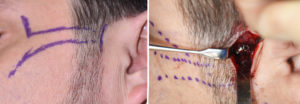
In the October 2017 issue of the Journal of Craniofacial Surgery an article entitled ‘Advantages of a Beveled Osteotomy on the Zygomatic Arch During Reduction Malarplasty’ was published. In this paper the authors describe beveling the osteotomy cut on the posterior zygomatic arch. This has numerous purported advantages including enhancing bony healing by increasing the cross-sectional area for bone contact between the cut edges, decreasing palpability on the osteotomy site, placing the osteotomy more posteriorly, preventing depression in the anterior cheek region, and reducing the need for metal hardware.
Beveling of posterior zygomatic arch osteotomy in cheekbone reduction is a technique that I have always done. It allows the cut end to be pushed inward like a sliding wedge and does avoid the use of metal hardware in an area where it can be more difficult to apply. A straight cut may allow the end of the arch to be pushed in a bit further but not appreciably more than a beveled osteotomy cut.
Dr. Barry Eppley
Indianapolis, Indiana


